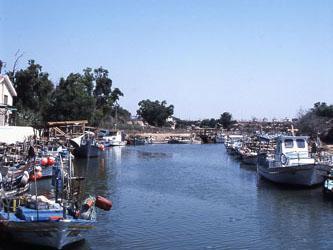- Our Municipality
- Services
- Visitors
- Information
- Documents
- Contacts
Surrounding area
 The towns and villages surrounding Agia Napa are less touristic and more agriculturally oriented than Agia Napa. Mild climate and fertile red soil together with underground water has contributed enormously to the increasing development of agriculture and farming. The main produce of the villages is potatoes, tomatoes, cucumbers, fresh vegetables, watermelons, melons and broad beans.
The towns and villages surrounding Agia Napa are less touristic and more agriculturally oriented than Agia Napa. Mild climate and fertile red soil together with underground water has contributed enormously to the increasing development of agriculture and farming. The main produce of the villages is potatoes, tomatoes, cucumbers, fresh vegetables, watermelons, melons and broad beans.
Everywhere throughout the countryside there are hundreds of wells especially board to pump water for irrigation purposes. Farms large and small characterise the charm and purity of these natural surroundings, which are primed for produce.
Paralimni - Protaras
Paralimni is the largest town in the free Famagusta district and is situated in the southeast of Cyprus. The word Paralimni means "settlement by the lake"
Historically, Paralimni was built on the shores of a shallow lake, which filled with water only in the wintertime. In the beginning of the 20th century, as a result of reclamation work, the whole of the lakebed was reclaimed for agricultural purposes. Paralimni has not always been where it is now. Originally it was built on a hill, which was situated between Dherinia and its present location.
However, in the 15th century, it was moved inland to avoid detection by the sea pirates. It is said that the first people to settle at Paralimni arrived just after the capture of the near town of Famagusta by the Ottoman Turks in 1571. The first settlement was called Saint Demetrius and this place still bears his name today.
Not far from Paralimni, at a location known today as Protaras, stood the old city-state of Leukolla. The city possessed a small safe harbour where the Athenian Demetrius Poliorketes in the year 306 B.C. sought refuge, lying in wait for Ptolemeos, one of the successors of Alexander the Great. In the ensuing battle Ptolemeos was defeated and fled to Egypt, leaving Cyprus for a while in the hands of Demetrius.
The first inhabitants of Paralimni were farmers. The location of Paralimni is favoured by a very mild climate which is conducive to the early-in-the year produce of vegetables and potatoes. Paralimni has lovely beaches and the most well known in the area is Fig Tree Bay in Protaras area.
Protaras is part of Paralimni which is more familiarly referred to as "the land of windmills" maintaining the nostalgic quality of the past. Picturesque but geared for tourism, Procaras has lovely sandy white beaches, and many restaurants, pubs and clubs.
Sotira
With a population of 1500 people, Sotira has taken its name from a church, situated in the centre of the village which is dedicated to the transfiguration of Jesus Christ the Saviour (Sotira in Greek means saviour). The church displays excellent examples of post Komninian art (13th - 16th centuries).
Near the east entrance of the village stands Agios Mamas, which was initially built in the 12th century and later rebuilt in the 16th. The present frescoes date back to the 16th century. About 16 miles to the west lays the cruciform church of Panagia Khordajiotissa, which also dates back to the 15th century. Its dome has been restored, a third church bearing the name of St. George is found in the area, which is an early Christian three aisle Syrian-type basilica. In the village of Sotira there is also a small Ecclesiastical Museum worth visiting.
Xylophagou
Built during Ottoman rule, it has taken its name from the first settler called Xerophagos (dry food eater). During the Byzantine years when the area was uninhabited several monasteries were built there. Today only their names remain. Efstathios and Saint Barbara were perhaps the two most important
Liopetri
Its name is derived from the fact that there are no rocks at Liopetri. The mediaeval church of Panagia is of interest and the church of Agios Andronikos is believed to have been built around the 15th century. It has an octagonal dome and some remnants of its murals can still be seen in the apse.
The "river" of Liopetri is a picturesque fishing refuge. Nearby are the remains of a Venetian watch tower. The French poet Arthur Rimbeaud worked in this area in the 1880's. The traditional craft of basket making can be seen here in Liopetri.
Phrenaros
It has been named after the Lusignan monks that lived in Panagia of Hortanion, a nearby monastery, and they were called Fremenors. As Nearchos Clerides mentions in his book "Villages and Cities of Cyprus", the monks could not support themselves and in 1468 they turned to Jacob, the Lusignan King of Cyprus, who gave diem a substantial sum of money. The village of Phrenaros has its own small Byzantine churches. Two of them, the Agios Andronikos and the Archangebs Michail date back to the 12th century. The church of Agia Marina has some interesting frescoes.
Dherinia
A small town next to Famagusta. Originally the village was called Yeninia but the people in their everyday use of the language changed it to Dherinia. History tells us that there is a strong possibility that settlers arriving from Yerinia in Cyprus after the Trojan War established a settlement, naming it after their mother city.
In the village there are three churches, which would be of interest to those who appreciate Byzantine art. The 15th century church of Agia Marina Panagia a church dedicated to the Holy Mother preserving some 17th century icons and finally, just near the village centre, stands the church of Agios Georgios, a small mediaeval church. In Dherinia there is aslo a Folk Art Museum of great interest.


